1. 深度学习可视化
深度学习的过程是一个黑盒子,模型通过大量的权重去学习拟合输入的数据和学习目标,模型的性能很大程度上取决于模型的输入的数据; 深度学习的拟合效果往往出乎我们的的想象,但是模型如何拟合数据和学习目标之间的关系,我们知之甚少。
有时候训练数据和验证集的选取,模型真正学习到的东西和我们人类认知背道而驰。网上看到的一则案例:有人采集了 100 张隐藏在树丛中的坦克照片,以及另 100 张仅有树丛的照片, 用神经网络训练一个识别坦克的分类器,在训练和验证上模型都达到了 100%的精确度,(100%基本上是数据泄露了); 原因出在 100 张坦克是在晴天拍摄,另外 100 张是阴天拍摄,模型似乎只关注到了天空的颜色。
本文针对 keras 对常用的机器视觉的可视化做了总结,
2. 可视化模型说明
本文要可视化模型为 densnet121,其他模型类似,只是卷积层不一样,目标是对于火灾的识别
from keras.applications import DenseNet169from keras.preprocessing import imagefrom keras.models import Modelfrom keras.layers import Dense, GlobalAveragePooling2Dfrom keras import backend as K
# 构建不带分类器的预训练模型base_model = DenseNet169(weights='imagenet', include_top=False)
# 添加全局平均池化层x = base_model.outputx = GlobalAveragePooling2D()(x)
# 添加一个全连接层x = Dense(1024, activation='relu')(x)
# 添加一个分类器,假设我们有200个类predictions = Dense(200, activation='softmax')(x)
# 构建我们需要训练的完整模型model = Model(inputs=base_model.input, outputs=predictions)
复制代码
查看模型结构
3. 特征可视化
对每一层卷积核的可视化帮助我们了解算法抽取的特征情况可以通过 keras 中的K.function封装输入到输出的函数,获取指定层的输出
# 训练好的模型为model.h5from keras import backend as Kfrom keras.models import load_modelimport tensorflow as tf
# 加载模型model_ = load_model('./model.h5')# 设置为测试阶段K.set_learning_phase(0)graph = tf.get_default_graph()
img_file = './test.jpg'img = cv2.imread(img_file)img = cv2.resize(img, (224, 224))img = img.astype('float32')img = img / 255.0 * 2 - 1img = np.expand_dims(img, 0)
def get_layer_feat_byname(graph, img, model_, layer_name='conv1/relu'): with graph.as_default(): layer_fn = K.function([model_.layers[0].input, K.learning_phase()], [model_.get_layer(layer_name).output]) layer_output = layer_fn([img, 0])[0] return layer_output
layer_output1 = get_layer_feat_byname(graph, img, model_, 'conv1/relu')layer_output2 = get_layer_feat_byname(graph, img, model_, 'pool2_conv')layer_output3 = get_layer_feat_byname(graph, img, model_, 'pool3_conv')layer_output4 = get_layer_feat_byname(graph, img, model_, 'pool4_conv')layer_output5 = get_layer_feat_byname(graph, img, model_, 'conv5_block32_concat')
复制代码
对于 densenet169, 我们可以选择每个 dense_block 层的最后一个 concat,也可以选择 transition_block pooling 前面的卷积层做展示,当然每一个卷积层都是可以做展示的,卷积层名称可以在summary()可以查到。本文 conv1/relu ,pool2_conv,pool3_conv,pool4_conv和最后的conv5_block32_concat
我们看下特征的可视化例子
可以看出
浅层的卷积特征主要形状和纹理
层数越深,特征越少,也也抽象
到最后一层卷积,可以看出模型主要的关注响应点,可以和人为主观上做一个对照,看一下模型识别到的是否目标真正的意图。
可以对输入图像做一定处理,比如遮罩掉一部分,看看特征的响应
如果看到过多的无用特征,只有少部分特征,可以考虑加下 dropout,看是否能提升性能
4. Grad-CAM 类激活热力图
由于每一层的特征数较多,只能初略观察下对目标的响应情况。而具体某个类别对应到图片的那个区域响应最大,也就是对该类别的识别贡献最大,没有一个直观的可视化。2016 年这篇文章给出了很好的解决方案,而且实现比较简单,Grad-CAM: Visual Explanations from Deep Networks via Gradient-based Localization。
Grad-CAM 思想来源 CAM(Class Activation Mapping),区别在于计算特征的响应权重不同,CAM 采用 GAP 层后的所有权重,因而 CAM 必须要有 GAP 层。而 Grad-CAM 采用目标类别对特征的梯度来作为响应权重, 对所有网络结构都适用。
过程描述
def output_heatmap(model, last_conv_layer, img): """Get the heatmap for image.
Args: model: keras model. last_conv_layer: name of last conv layer in the model. img: processed input image.
Returns: heatmap: heatmap. """ # predict the image class
preds = model.predict(img) # find the class index index = np.argmax(preds[0]) print('index: %s' % index) # This is the entry in the prediction vector target_output = model.output[:, index]
# get the last conv layer last_conv_layer = model.get_layer(last_conv_layer)
# compute the gradient of the output feature map with this target class grads = K.gradients(target_output, last_conv_layer.output)[0]
# mean the gradient over a specific feature map channel pooled_grads = K.mean(grads, axis=(0, 1, 2))
# this function returns the output of last_conv_layer and grads # given the input picture iterate = K.function([model.input], [pooled_grads, last_conv_layer.output[0]]) pooled_grads_value, conv_layer_output_value = iterate([img])
# We multiply each channel in the feature map array # by "how important this channel is" with regard to the target class
for i in range(conv_layer_output_value.shape[-1]): conv_layer_output_value[:, :, i] *= pooled_grads_value[i]
# The channel-wise mean of the resulting feature map # is our heatmap of class activation heatmap = np.mean(conv_layer_output_value, axis=-1) heatmap = cv2.resize(heatmap, (img.shape[1], img.shape[2]), cv2.INTER_LINEAR)
heatmap = np.maximum(heatmap, 0) heatmap /= np.max(heatmap) print(heatmap.shape) return heatmap, index
复制代码
from keras import backend as Kfrom keras.models import load_modelimport tensorflow as tfimport cv2
# 加载模型model_ = load_model('./model.h5')# 设置为测试阶段K.set_learning_phase(0)graph = tf.get_default_graph()
img_file = './test.jpg'img = cv2.imread(img_file)img = cv2.resize(img, (224, 224))img = img.astype('float32')img = img / 255.0 * 2 - 1img = np.expand_dims(img, 0)
heatmap, index = output_heatmap(model_, 'conv5_block32_concat', img)
复制代码
我们来看一下效果
5. 总结
本文演示了 keras 在深度学习可视化的两种方式,希望对你有帮助,欢迎交流 @mintel。
总结如下
使用 summary 查看 layer 名称
使用 K.function 和 model.get_layer 建立模型输入和输出, 进行特征可视化
Grad-CAM 简单高效的类别响应可视化,图像的哪些像素决定了类型输出。关键在于类别输出对特征的梯度
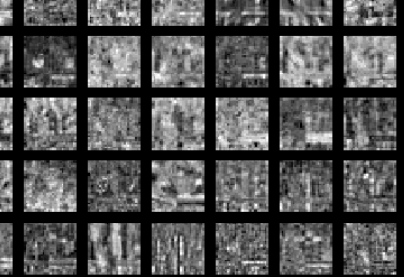

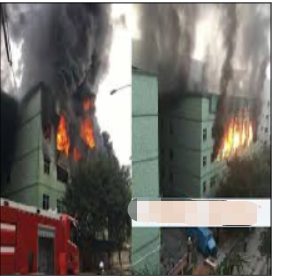
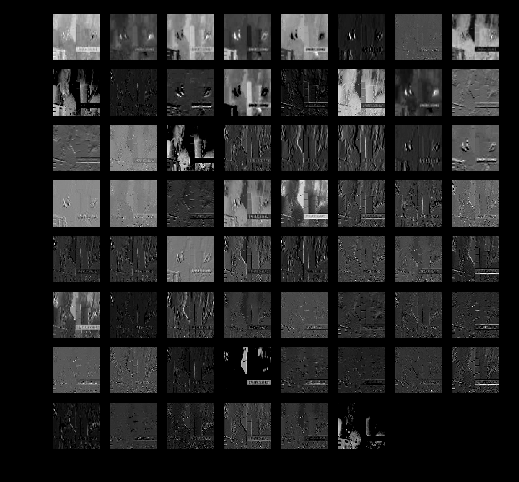
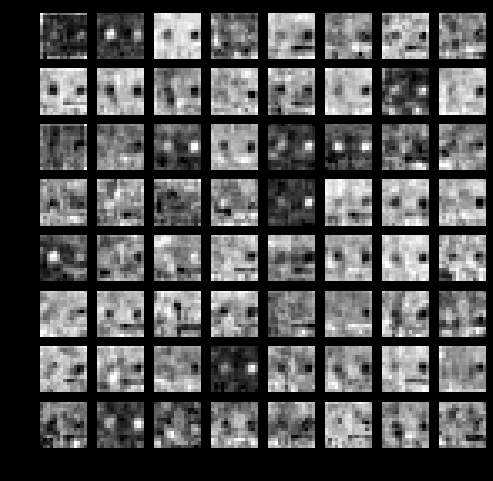
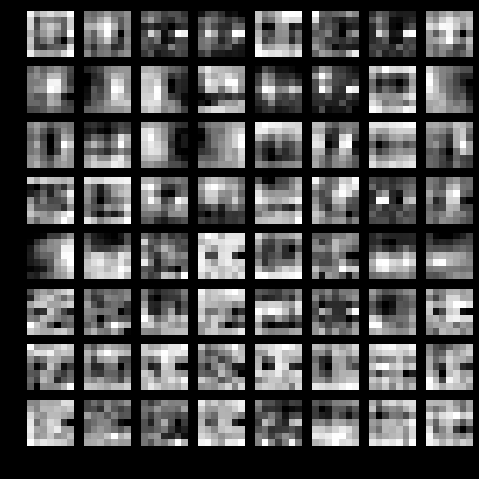

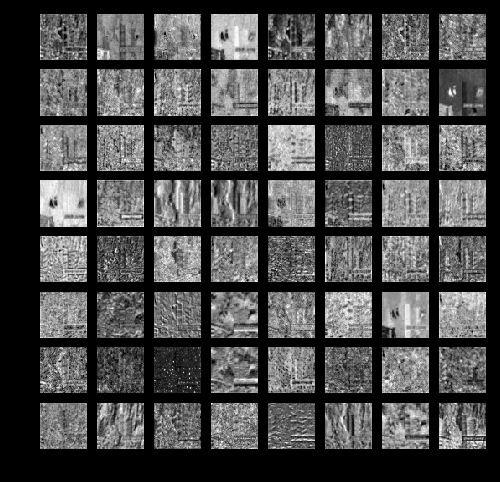
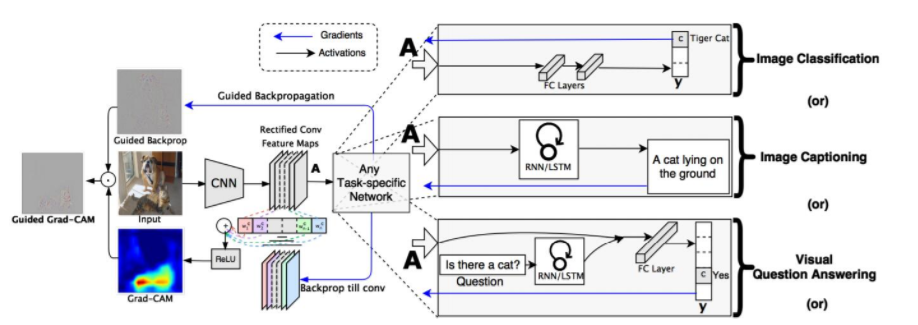

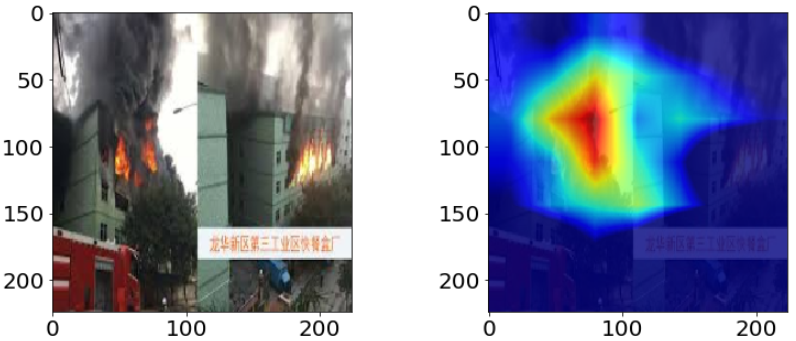











评论